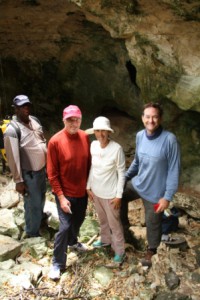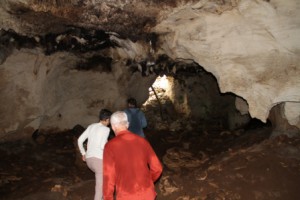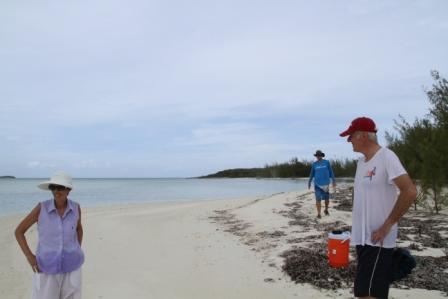10th June 2015
A rare visit to one of the Caribbean’s last uninhabited paradises
There can be few more idyllic and peaceful settings for breakfast than Daniel’s cafe in Middle Caicos.
Fuelled with the owner’s delicious conch grits, and his warm welcome, our small expedition set off with another local, boatman Dolphus Arthur, to our destination – the Caribbean’s largest uninhabited island, East Caicos.
The sheer remoteness of East Caicos was marked by our trip: 30 minutes by ferry from Provo to North Caicos,  45 minutes by road to Middle Caicos, and then about an hour’s open sea crossing to the nearest, northernmost point of the island.
45 minutes by road to Middle Caicos, and then about an hour’s open sea crossing to the nearest, northernmost point of the island.
There we disembarked into the island’s wetlands and made our way through some reasonably light vegetation to one of the few signs of an earlier habitation by man, a very overgrown track made to transfer- extraordinary as it may now seem – bat’s dung, guano, from some nearby caves to other islands as fertiliser.
The process stopped about 100 years ago, and since then there has been no permanent population on the island.
After a walk of no more than 2 kilometres, but made slow by heavy overgrowth sometimes having to be cut down by our guide Mark Parrish, we found one of the many entrances to an amazing complex of caves.
For most of the way we could walk through them standing and sometimes crouching, occasionally ducking to miss the disturbed bats.
 Caves always have their own surreal attraction, and East Caicos’s were no exception, but with the added allure of inscriptions dating back hundreds of years, to the Taino first ever inhabitants of Turks and Caicos.
Caves always have their own surreal attraction, and East Caicos’s were no exception, but with the added allure of inscriptions dating back hundreds of years, to the Taino first ever inhabitants of Turks and Caicos.
After an increasingly hot walk back through the caves and to our boat it was time for a well earned rest on one of the island’s idyllic beaches.
We were able there, as well as during our trek to the caves, to spot some of East Caicos’s rare birds, plants and animals.
There are still, as the RSPB study by Kathleen Wood is aiming to demonstrate, a number of species which are endemic to TCI, and exist literally nowhere else in the world.
These species include certain lizards, a Whistling duck, and a Reddish Egret.
The last leg of our expedition was to TCI’s highest point, Flamingo Hill, which we could see rising from what must be one of the Caribbean’s, and the Americas, most unspoilt stretch of beach, running for tens of miles all the way to South Caicos.
After a quick plunge into waters barely ever swum in by humans, but teeming with fish, it was time to return under Dolphus’s skilled boatman ship through reefs and some very shallow passages to Bambarra Beach.
I suspect few visitors to TCI, and possibly even some of our local residents, can have any idea what a jewel sits on the edge of the islands.
We should all be grateful for the passion and enthusiasm of organisations like the RSPB and Big Blue, and local boatmen like Dolphus, for keeping and preserving East Caicos as the region’s last remaining, biggest, uninhabited paradise.

1 comment on “A rare visit to one of the Caribbean’s last uninhabited paradises”
Comments are closed.